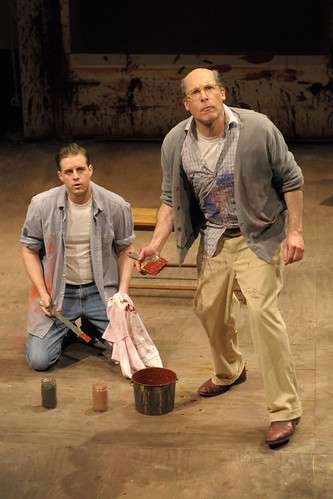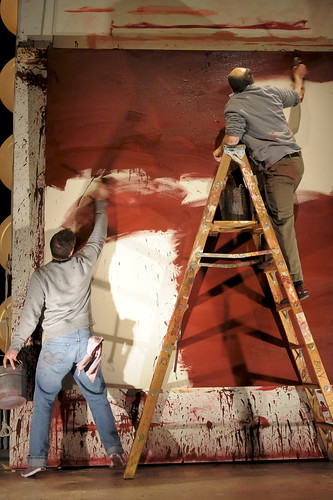Berkeley Rep’s pulsating Red
John Brummer (left) is assistant Ken and David Chandler is Mark Rothko in John Logan's drama Red at Berkeley Repertory Theatre. Below: Brummer and Chandler prepare a canvas in a show-stopping moment. Photos by www.kevinberne.com.
You've heard that insulting phrase, "As exciting as watching paint dry." Well in Berkeley Repertory Theatre's Red, you do watch paint dry, and it's surprisingly exciting.
This is one of those new American dramas that arrives at the local regional level lauded with awards and high expectations. John Logan's drama won a passel of Tony Awards, including Best Play, so it wouldn't be surprising if audience members showed up with minds made up one way or the other – oh, this is going to be good because the people in New York (and London) say it is; or, oh, there's no way this can actually be good because it has received too much praise.
It's the kind of artistic situation about which painter Mark Rothko, the subject of Logan's play, would have a definite, probably loud, opinion.
Writing a play about a volcanic talent like Rothko can't help but tame him in some ways. It puts a frame around him, or at least a vision of his life, and lets us contemplate him the way we might one of his paintings. But Logan fights admirably the urge to make this monster of an artist nothing more than a pleasant evening of middle-class entertainment. He very rightly lets Rothko himself turn his life into a play of sorts.
As playwright/artist, Rothko has crafted his own character: a great man of painting, a legend in his own time (and mind), an ego-fueled maniac with an extraordinary mind and a talent for eviscerating anything in his path. He creates his own set – in this case it's a large studio filled with what will come to be known as the Seagram Murals – and as much as he writes his story in the reds and maroons and browns and blacks on those canvases, he also engineers the drama of his rages, resentments and pontifications.
Inviting someone to look, really look, at one of his paintings, Rothko begins the play essentially telling us how to watch the play as well. "Let it pulsate," he says ("pulsate" is a word that comes up a lot in connection with his painting). "Let the picture do its work...Lean into it...meet it halfway."
The really interesting thing about Logan's Rothko is that he can be just awful – the very epitome of the over-inflated, pompous arr-teest – but he's also likeable. He's funny, and a lot of what he says is absolutely true, and if not exactly true, then extremely interesting. At least that's how he's played by the marvelous David Chandler in this powerful production helmed by Les Waters.
Chandler gives an outsize performance with entirely believable glimpses of the man underneath the character of "Rothko the Great." What this Rothko needs most is an audience, although he disdains most of the human race. It's even proposed that there's no one on the planet Rothko really deems worthy of looking at his paintings. But attention must be paid to the great artists, so aside from the easily dismissed art world, he brings into his world a young man, a new assistant named Ken, to help with the enormous Seagram murals.
It's with this character that Logan lays on his paint a little thick, though John Brummer's subdued performance mellows the melodrama. We get a tragic back story and an overt reason for the young man to look to Rothko as a father figure, one he, as a young artist, will have to displace. It's what Rothko and his contemporaries did to the surrealists and the cubists, and its' a vision of what's to come for Rotkho at the hands of artists like Warhol, Lichtenstein and Johns. Logan also leans heavily on the foreshadowing of Rothko's suicide, but how do you resist a life (and death) of such drama?
Waters cannily creates a vision of painting as theater. Louisa Thompson creates a set that is at once a highly realistic painting studio and a beautifully realized piece of theater in itself. The rear panels of the stage move to expose a wall of lights that intensify Rothko's discussion of light and why natural light is not good enough for him. Lighting designer Alexander V. Nichols uses this wall of lights effectively – I half expected a blinding flash at some point, but happily that moment never came. He also subjects us to the vulgar glare of the overhead fluorescents that Rothko wisely never uses.
Logan, like Rothko, wants this work to be significant, but also like Rothko, he's able to puncture the pretentions of significance quite effectively. There's a lot of humor in this work, with "work" being the operative word. One of the highlights of the 90-minute show is when the two men set about working, with no words at all (only the strains of classical music coming from Rothko's well-used record player). The stretch an enormous canvas, hang it on the wall, set up a ladder and two buckets of blood-red paint and go to town creating a base layer for one of Rothko's Seagram works.
In the end, Red feels as significant as it is entertaining. Logan and Waters inspire thought about pulsating art and human conflict. What really resonates is one of Rothko's rants about his purpose as an artist and the state of our nation. "We're a smirking nation living under the tyranny of 'fine.' How are you? Fine. How was your day? Fine. How are you feeling? Fine. Well, let me tell you, everything is not fine!"
He ends his screed much the way he starts the play, letting us know why we were here. "I am here to make you think," he says. "I am not here to make pretty pictures."
[bonus interview]
I interviewed playwright John Logan and director Les Waters, who has left his post as Berkeley Rep's associate artistic director to become artistic director of the Actors Theater of Louisville.
Read the feature here.
FOR MORE INFORMATION
John Logan's Red continues an extended run through May 12 at Berkeley Repertory Theatre's Thrust Stage, 2025 Addison St., Berkeley. Tickets are $14.50-$83 (subject to change). Call 510-647-2949 or visit www.berkeleyrep.org for information.

